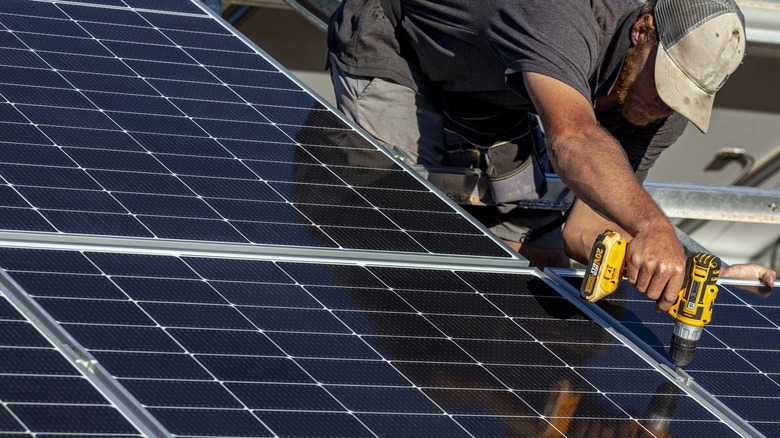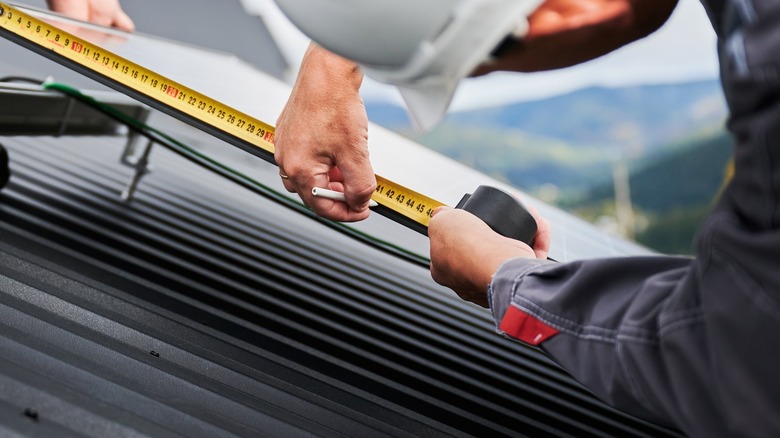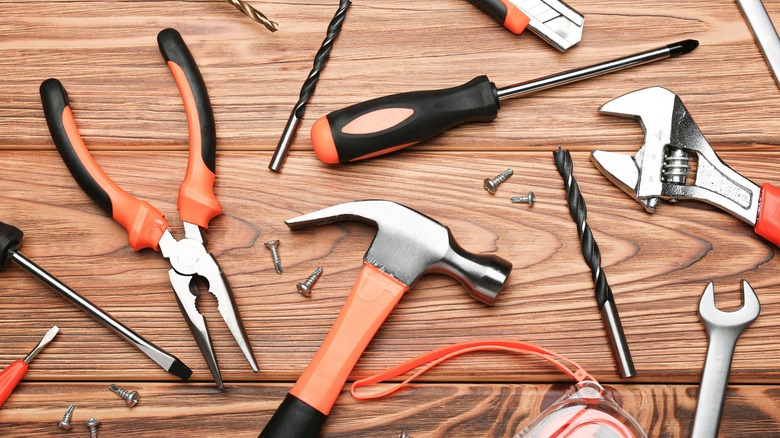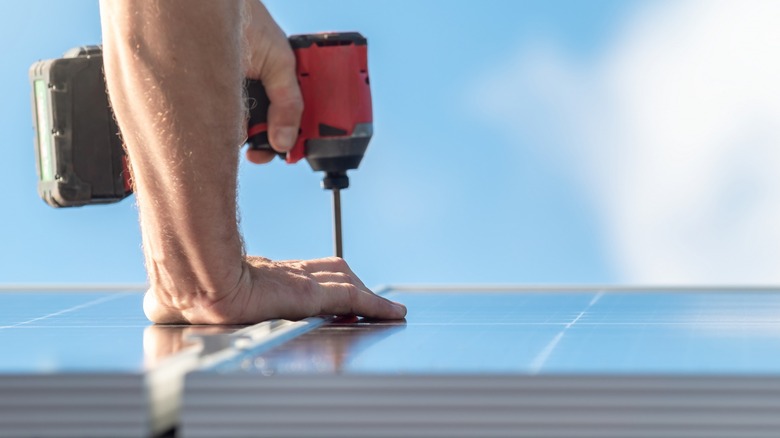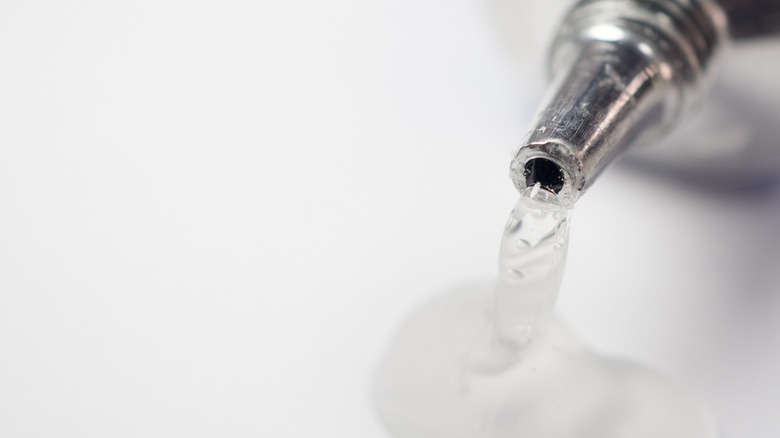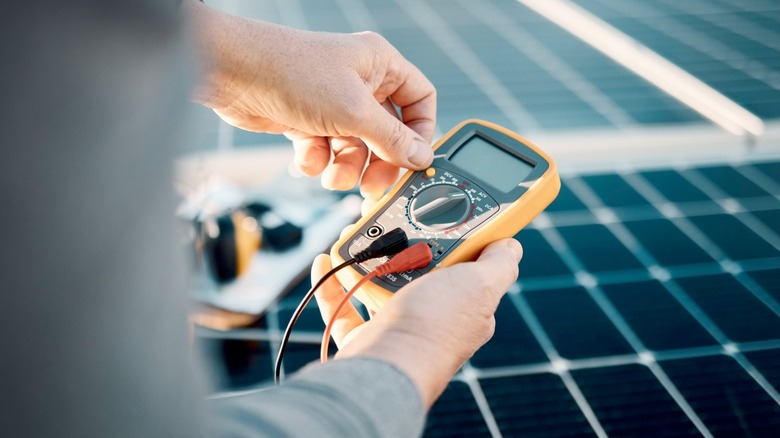5 Tools That Will Come In Handy When Installing Your Own Solar Panels At Home
The initial cost of setting up solar in your home may seem expensive. In fact, there are some hidden costs associated with home solar panels that you need to know upfront. But giving renewable energy a chance can pay off in the long run — for you and for the environment. If you've decided this would be a fun DIY project to keep costs low, while also keeping you busy for the next couple of hours, days, or weeks, that's splendid. It can be both rewarding and challenging. However, ensure you educate yourself on everything you need to know before installing solar panels in your home.
If you decide this is the right investment for you, then you've most likely bought the most important pieces already, such as the solar panels, the battery, the charge controller, the inverter, and the cables. Now, it's time to piece them all together so they can get to work converting the sun's energy into electricity you need to power your home.
If you plan to install solar panels yourself, you'll need some tools that may be obvious, but not always. If you don't have a couple of them, it could slow you down a great deal.
So, without further ado, here are five types of tools that you should make sure to have on hand during a DIY solar install.
Measuring and marking tools
Precision is important when performing a solar install. Getting the arrangement of solar equipment correct on the first try saves you a lot of time. It also saves you from the hassle of re-adjustments after turning the system on. If you're installing multiple panels at once, you want to ensure they're arranged consistently.
Measuring tape is useful for ensuring accurate placements. First, you'll want to use your measuring tape to assess the area where the solar panels will be installed. Getting the dimensions right is crucial, whether it's a rooftop or a ground-mounted system. Hopefully, before buying any equipment, you'll have already measured the length and width of the space to calculate how many solar panels you need to power your home, as well as how many panels you can fit and the precise order they'll need to be arranged.
Many of the tools SlashGear recommends to help finish a basement remodel or to get started on your next woodworking project can help here too. One of those tools is a torpedo level. This tool can help make sure the brackets and panels are evenly aligned. Marking tools such as string lines, chalk, and marker pens can also help you pinpoint exactly where each panel and rail should go.
Hand tools
Any DIY project usually involves a lot of screwing and unscrewing, and this will be no exception. Consequently, you should have a good set of screwdrivers (many manuals tend to call for a Phillips-head), pliers, torque wrenches, flat pry bars, wire cutters, wire crimpers, and wire strippers. And speaking of wires, you might also need some MC4 connectors, which are a standard type of connector for solar panels. They are also waterproof and UV-resistant.
The reason you need the screwdrivers, pliers, and torque wrenches is so they'll help you when you're trying to fasten wires to the charge controller, for instance, or simply trying to hold some nuts and bolts in place, or even help when applying the right amount of force to fasten a screw. Any screw that isn't tightened correctly might lead to a panel that's loose or an electrical connection that's not secure.
Instruction manuals typically say you will need one pair of MC4 connectors (one male and one female) for each connection between panels. The number of MC4 connectors you use depends on the number of solar panels you plan to install and how you intend to wire them, whether in series or parallel.
When you're on the roof, trying to install the panels, you'll also need a hammer and, depending on the roof, a flat pry bar. The hammer comes in handy to tap around, listening for different sounding thuds that indicate rafters below. The flat pry bar is necessary for carefully pulling up roof shingles.
Power tools
We'll let you decide whether a hammer drill or an impact driver will be your daily driver on this project. But, just so you know, a cordless drill is super important to getting things done quickly and efficiently. And here's a ranking of every major brand of cordless drill, from best to worst, to help you choose the right one. However, make sure you get the right drill bits along with it, and if you want to be able to file away any rough edges from the holes you've drilled, consider getting a reamer too.
The benefit of a cordless power tool is that they get the extra wires out of the way and prevent the chances of accidents when you're high up or trying to get into awkward positions. You might also need a power saw to cut through rails. If you already own a hacksaw, that'll work just fine. Another tool you'll find yourself reaching for is a heat gun to help you bend and manipulate conduits that go around corners and through odd places.
Sealants and lubricants
When you're setting up solar panels at home, you'll notice that drilling holes is a huge part of the process. You need them for getting those wires in and out. But here's the thing: those holes can create a passage for water to sneak into places you really don't want it to be, like inside your walls or into your electrical system. That's a recipe for a serious fire hazard.
Having a good waterproof sealant comes will help avoid those issues. You'll want to slather it carefully but generously around any holes you drill, whether it's for bolting down your solar panel mounts or running cables into the house.When choosing a sealant, look for one that is UV and moisture resistant, compatible with the materials you'll be sealing, and can withstand extreme weather conditions. It's also a good idea to choose one that's environmentally friendly.
Pulling wires through conduits can also be a real struggle. That's where lubricants come in handy. They make pulling wires through conduits a whole lot smoother. Lubricants keep the wires from getting snagged or damaged as you pull them, which is super important for safety. There are different types of wire-pulling lubricants in the market, but whichever one you buy should ideally be greaseless, non-combustible, non-conductive, and non-corrosive.
Both sealants and lubricants can get messy. So, having a rag on hand to wipe up any spills or smears keeps your work area clean and ensures you don't leave a trail of goop behind.
Multimeter
A digital multimeter is a device that comes in handy during installation and maintenance of your setup. It's a tool that measures how much voltage, resistance, and current an electrical circuit is outputting. With it, you can tell if your solar panels are working as they should, ensuring they're safely pumping out the right amount of voltage. Multimeters cost anywhere from $20 to over $200, depending on how sophisticated the model is.
While a multimeter helps keep your solar installation safe and sound, don't forget to look after your own safety, too. When you're up on your roof dealing with panels and wires, there's a real risk of falling.
Beyond choosing the right panel system and tools to ensure your setup is all nice, also try to get the right gear to keep you safe. We're talking about things like a ladder or a sturdy harness if you're working high up, slip-resistant shoes so you don't slide off the roof, and maybe even a hard hat because, really, better safe than sorry.
Now, a successful installation is only the beginning. You might be wondering: How long will my solar panels last? While it all depends on a number of factors, the Solar Energy Industries Association says they could last for more than two decades. However, how you clean your solar panels matters in keeping them working at their best.
